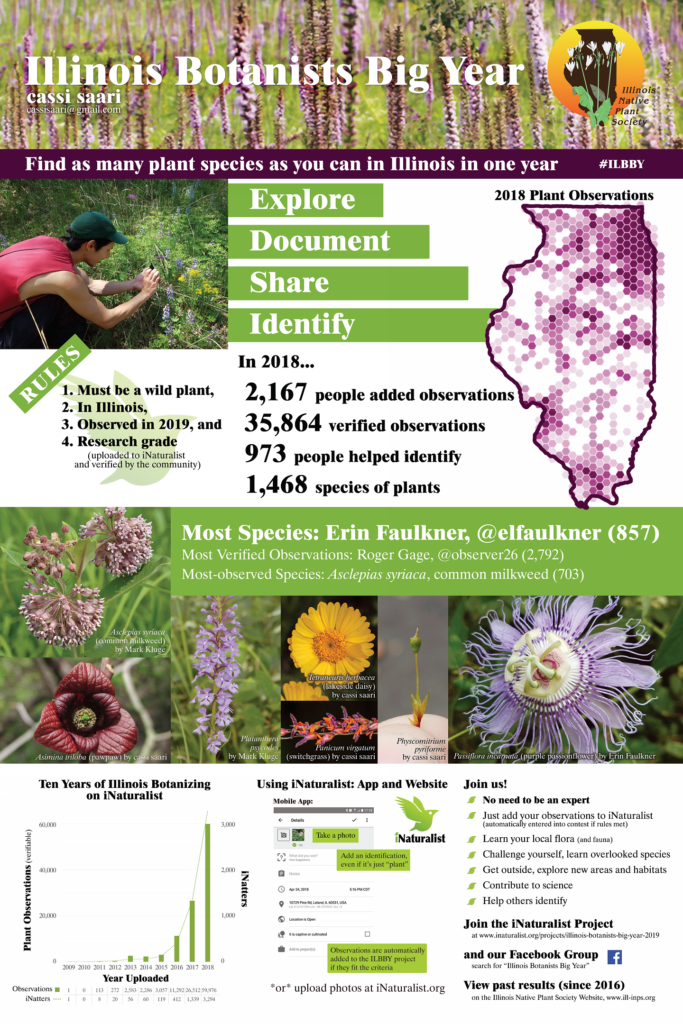Find the most plant species in Illinois in a single year and rejoice in your victory!
In 2016, the Illinois Native Plant Society hosted the first annual Illinois Botanists Big Year. Anyone may participate, from professional botanist to plant identification novice, by uploading photographic proof of their plant sightings to an online database: iNaturalist. Through the website or mobile apps, botanical enthusiasts upload photos, a species identification, GPS location, date of sighting, and field notes. Since other iNaturalist users can help with identification, participants need not be plant experts and can learn quite a bit about plants just by snapping photos and engaging with the community.
In 2018, we had:
35,864 research grade observations of plants
1,468 species
2,167 observers
973 identifiers
Most species goes to @elfaulkner, Erin Faulkner, with an impressive 857 wild plant species observed in Illinois in 2018. And that’s just research grade! She has an additional ~80 species that still need confirmation. Can you help identify?

The geographic coverage of the state was pretty impressive. Last year was a huge year. iNaturalist globally continues to double each year and that was reflected in Illinois as well. Also gosh there are still over 22,000 “needs ID” plant observations in 2018 alone.
All stats as of 29 January 2019. These are research grade observations only:
Most Species
1. @elfaulkner — 857
2. @bouteloua — 772
3. @sanguinaria33 — 729
4. @sedge — 593
5. @skrentnyjeff — 530
6. @missgreen — 451
7. @observer26 — 428
8. @johnhboldt — 416
9. @jackassgardener — 325
10. @psweet — 270
Most Observations
1. @observer26 — 2,792
2. @bouteloua — 2,470
3. @sanguinaria33 — 1,470
4. @elfaulkner — 1,301
5. @annechw — 1,226
6. @skrentnyjeff — 1,044
7. @sedge — 966
8. @johnhboldt — 963
9. @taco2000 — 851
10. @missgreen — 629
Other Awards
The Sedgehead (most species of Carex): @sanguinaria33 with 41
The Grassmaster (most species in Poaceae): @elfaulkner with 62
The Sporophyte (most nonflowering plants): tie between @elfaulkner and @bouteloua with 28
The 100% Naturalist (at least 500 observations, lowest standard deviation between number of observations in each of iNaturalist’s iconic taxon groups: plants, fungi, fishes, amphibians, reptiles, birds, arachnids, insects, mammals, molluscs, chromista, and protozoa): @paulroots !
The most-observed species was common milkweed (Asclepias syriaca). The most-observed non-native species was chicory (Cichorium intybus).
Huge thank yous to top identifiers @evan8 @bouteloua @mcaple @elfaulkner @eattaway92 @sedge @sanguinaria33 @bugman1388 @coreyjlange and @missgreen. Especially @sedge for those recent sedge IDs!
Our most speciose botanist @elfaulkner / Erin Faulkner says:
This summer I used iNat to document my quest to knock a bunch of IL nature preserves off my list. I visited nearly 20 new nature preserves, parks, and natural areas ranging from the Ohio River to the slag piles of southeast Chicago to the sand prairies along the north Mississippi. Some of my favorites were Brown Barrens shale glade in Union County, where I had to scramble up a steep bluff in the pouring rain to find a weird assemblage of species perched at the top (prairie tea [Croton monanthogynus], downy milkpea [Galactia regularis], creeping lespedeza [Lespedeza repens], and redring milkweed [Asclepias variegata]…Little Grand Canyon in Jackson County, where I had to turn back halfway because I was alone with no cell reception and the bare rock trail was slick with rain, but not before seeing odd things clinging to the rock outcrops like sparkleberry [Vaccinium arboreum], pencilflower [Stylosanthes biflora], hairy goldenrod [Solidago hispida], and cranefly orchid [Tipularia discolor]…and Thomson Fulton Sand Prairie in Whiteside County, which was a bizarre alien landscape so covered in prickly pear cacti it was difficult to find a place to step.
Our most observose naturalist @observer26 says:
I really enjoyed the ease of use of iNat to upload. I like the excuse to take extra pictures to share. I have to admit that I used iNat as an excuse to go places that I normally would not have had the opportunity.
Most-favorited photos (tie):



And tons of new documentations in Illinois on iNaturalist in 2018. Way too many for me to list here. Check the 2018 column in the following links:
▶Non-flowering plants
▶Monocots excluding Poales
▶Poales (grasses, sedges, rushes, & friends)
▶Plants in Asterales (sunflower family and friends)
▶Plants in Fabales (pea family and friends)
▶Plants in Lamiales (mint family and friends)
▶Plants in Rosales (rose family and friends)
▶Plants in Brassicales (mustard family and friends)
▶Plants in Ranunculales (buttercup family and friends)
▶Plants in Caryophyllales (pink family and friends)
▶All other (eu)dicots except the groups above
Now time to:
Join the Illinois Botanists Big Year 2019
See you out there!
